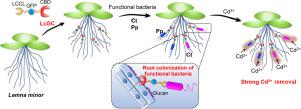Water Research ( IF 11.4 ) Pub Date : 2022-06-14 , DOI: 10.1016/j.watres.2022.118746 Li-An Feng 1 , Boyuan Liang 1 , Xinlin Zeng 1 , Cong Shi 2 , Hongda Yin 1 , Yuming Feng 1 , Yuqiao Chen 1 , Qilin Yu 1

|
Functional bacteria promote the efficiency of phytoremediation by enhancing plant growth and participating in decontamination. However, their activity is frequently compromised by the weakness of their interaction with plant roots. In this study, we designed the artificial protein LcGC composed of a bacterium-binding domain, a GFP fluorescence reporter, and a carbohydrate-binding domain to function as a physical contact between functional bacteria and plant roots. This protein was then expressed in an engineered yeast cell factory and extracted to assess its effect on rhizosphere microbiome composition, plant growth, and cadmium removal in a simulated phytoremediation system containing the remediation plant Lemna minor and the functional heavy metal-capturing bacteria Cupriavidus taiwanensis and Pseudomonas putida. LcGC efficiently bound bacterial cell wall components and glucan, endowing it high efficiency to bind both functional bacteria and plant roots. Scanning microscopy and microbiome analysis revealed that LcGC enhanced root recruitment and colonization of functional bacteria on the root surfaces. Furthermore, LcGC with the aid of single C. taiwanensis or of C. taiwanensis and P. putida in combination promoted plant growth, enhanced tolerance to cadmium-induced oxidative stress, and consequently improved cadmium-removing capacity of the plants, with the percent of cadmium removal reaching up to 91% for LcGC plus C. taiwanensis, and to 96% for LcGC plus C. taiwanensis and P. putida on day 7. This study provided a physical contact-based strategy to enhance the interaction between functional microbes and plant roots for efficient phytoremediation.
中文翻译:

工程细菌结合蛋白促进功能性细菌的根部募集,以通过植物修复提高废水中镉的去除率
功能性细菌通过促进植物生长和参与净化来提高植物修复的效率。然而,它们的活性经常受到它们与植物根系相互作用的弱点的影响。在这项研究中,我们设计了由细菌结合域、GFP 荧光报告基因和碳水化合物结合域组成的人工蛋白 LcGC,作为功能性细菌和植物根部之间的物理接触。然后将该蛋白质在工程酵母细胞工厂中表达并提取,以评估其在模拟植物修复系统中对根际微生物组组成、植物生长和镉去除的影响,该系统包含修复植物Lemna minor和功能性重金属捕获细菌Cupriavidus taiwanensis和恶臭假单胞菌。LcGC有效地结合细菌细胞壁成分和葡聚糖,使其高效结合功能性细菌和植物根部。扫描显微镜和微生物组分析显示,LcGC 增强了根表面功能细菌的根募集和定殖。此外,LcGC 与单一的C. taiwanensis或C. taiwanensis和P. putida组合促进植物生长,增强对镉诱导的氧化应激的耐受性,从而提高植物的镉去除能力,百分比为LcGC + C. taiwanensis的镉去除率高达 91%,LcGC + C. taiwanensis高达96%和恶臭假单胞菌在第 7 天。这项研究提供了一种基于物理接触的策略,以增强功能性微生物与植物根系之间的相互作用,从而实现有效的植物修复。











































 京公网安备 11010802027423号
京公网安备 11010802027423号